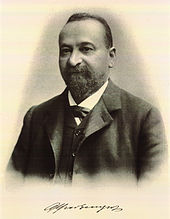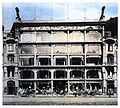Gerngross (department store)
| Gerngross Department Store AG
|
|
|---|---|
| legal form | Corporation |
| founding | 1879 |
| Seat | Vienna , Austria |
| management | Günther Meier |
| Branch | retail trade |
| Website | http://www.gerngross.at/ |
Gerngross is one of the most famous department stores in Vienna at Mariahilfer Strasse 42-48 in Vienna's 7th district, Neubau . The department store is operated by Gerngross Kaufhaus AG.
history
Alfred Abraham Gerngroß (1844–1908) from Forth near Nuremberg , who had learned the trade at Herzmansky , who was founded in 1863, founded a fabric shop with his younger brother Hugo (1857–1929) on the corner of Mariahilfer Straße 48 on September 26, 1879 Kirchengasse. After a brief competition with his former employer August Herzmansky , the two companies tried to work together, but this was unsuccessful, which is why this connection was dissolved again in 1881. As a result of subsequent success, the company was able to acquire 13 neighboring houses over time. In 1883 the company was converted into a company, the business developed into the largest department store in Vienna and subsequently the largest department store in the monarchy .
From 1902 to 1904 Ferdinand Fellner and Hermann Helmer ( Fellner & Helmer office ) built a new five-storey concrete stand construction on Mariahilfer Straße. The outer facade came from Fellner's son Ferdinand III. The building contained five lifts and one escalator . After the death of Alfred Gerngroß, the company was taken over by his sons Albert (1874–1972), Robert (1876–1942 in the Shoah ) and Paul (1880–1954) and on December 22, 1911 it became a stock corporation under the name A. Gerngross A. = G. (see picture Gerngross Vienna advertisement 1912 ) converted. In its prime, the department store had around 1,600 employees. The building was crowned with a lighthouse in 1926 .
As early as the early 1930s, the department store was exposed to politically motivated attacks by the National Socialists - for example, an attack just before Christmas 1932 attracted particular attention. National Socialists broke into the lively department store on December 18, 1932, and on the golden (shopping) Sunday threw tear gas and stink bombs , causing a mass panic among buyers that left numerous injuries.
After the Anschluss in 1938, the Gerngroß family had to flee and emigrated to Montevideo . The department store was " Aryanized ". The name was now store the Vienna - Ludwig & Co . At the end of World War II , the house was badly damaged and looted, but was soon rebuilt. In 1947 Paul Gerngroß returned to Vienna and was able to take over management again in the course of a restitution process . After his death in 1954, the Gerngross family sold the shares to the Hertie Group in 1957 . 1965 Gerngross was approved by the corporation General Shopping in Luxembourg adopted. As a result, Gerngross opened further branches in Vienna (for example in Floridsdorf Am Spitz ) and in other Austrian cities (for example EKZ Gerngross in Klagenfurt).
In 1978 the company received the state award and has been allowed to use the federal coat of arms in business transactions ever since .
Part of the main building was replaced on December 14, 1966 by a new building by Adolf Wölzl . On February 7, 1979, in the course of revitalization work involving welding work to remove an escalator, a major fire broke out that almost completely destroyed the building. Major parts of the building structure had to be removed. The new building by architect Georg Frankl was opened on March 18, 1980 . A large number of complaints about construction noise at night led to a night work ban in 1981.
On January 1st, 1984 the cooperative company Konsum Austria took over Gerngross and Herzmansky . After Konsum became insolvent in 1995 , the Gerngross company went to a consortium of Palmers (75%) and Hans Schmid (the founder of the advertising agency GGK , 25%) in 1996 , who had the department store converted into the Gerngross CityCenter in 1997 . On February 27, 1997 the house was reopened as a shop-in-shop system with 30,000 m 2 of sales area on seven sales levels. The house now contains 16 escalators and a glass dome . Since the hoped-for business success did not materialize, the Gerngross property was sold to Deka Immobilien Investment GmbH on January 1, 2004 for 112.3 million euros , while the Steffl department store property has been directly and indirectly almost 100% owned since at least 2006 by Hans Schmid and his family foundation.
On December 2, 2005, the WirtschaftsBlatt reported that S Immo had taken over the majority of Gerngross Kaufhaus AG , which also includes the Steffl and the former Herzmansky department stores, from the Palmers Group . This was incorrect information because the property is still owned by Deka Immobilien Investment GmbH .
In 2005 the owner decided on a general renovation with a simultaneous restructuring of the house and announced an architecture competition for this, which the Graz office LOVE architecture and urbanism had won. On January 11, 2010, the renovation began while business was still going on. The total investment volume amounts to 40 million euros. Since October 21, 2010, Gerngross has had a new design, new architecture and new brands.
The additional building on Mariahilfer Strasse in Art Nouveau style (1904)
Sales areas
The department store offers customers a wide variety of products on five floors. With the construction of the U3 underground line, direct access to the basement has been built at the Neubaugasse station . There is a Merkur supermarket there. The perfume department and women's department with companies such as Marionnaud , MAC Cosmetics , Clinique , Wolford and Billy Jeans are located on the ground floor . On the first floor there are fashion items from companies such as Zara , Esprit , Tom Tailor , Görtz , Betty Barclay , Desigual , Passport , Bandolera and underwear from Triumph . Craft supplies and the children's department are on the second floor. On the third floor there are only sports articles from Sports Experts , on the fourth floor and partly on the fifth Saturn . The gastronomy department with the Japanese restaurant Akakiko is on the fifth floor. In summer, when the weather is good, the rooftop coffee house is open and offers a panoramic view of the city. The restaurants and bars on the top floor can be reached with a separate elevator at the main entrance on Mariahilfer Straße even after the shops are open and can therefore be visited until late in the evening.
literature
- F. Fellner: The fashion department store A. Gerngroß in Vienna . Vienna 1905.
- Elfriede Faber: New building . Pichler, Vienna 1995, ISBN 978-3-85058-065-6 .
- Andreas Lehne: Viennese department stores 1865–1914 . Franz Deuticke, Vienna 1990, ISBN 978-3-7005-4488-3 .
Web links
- Website Gerngross
- Vienna then-now : Mariahilfer Strasse, Gerngross , March 7, 2009. Accessed April 30, 2010.
- Website of the Vienna Professional Fire Brigade : The fire in the Gerngross department store on February 7, 1979 . Retrieved September 25, 2013.
Individual evidence
- ↑ See: Michael John, Albert Lichtblau , Erich Zöllner: Melting Pot Vienna - then and now. On the past and present of immigration and minorities . Böhlau, Vienna-Graz, 1990, ISBN 978-3-205-05209-8 , p. 48.
- ↑ a b c d e f Gerngross website: From fabric shop to CityCenter - a brief overview of a long success story. Retrieved September 10, 2012.
- ↑ See Vera Pawlowsky, Hans Wendelin: Arized economy, robbery and return. Austria from 1938 until today . Vienna 2005, p. 16.
- ↑ Gerhard Botz: Violence in Politics , Vienna 1976, p. 274. The Nazi agitation against department stores had already led to graffiti and attacks in Germany in the 1920s. See also the keyword department store tower .
- ↑ Kurt Stimmer: 1979 - the year of the great Viennese fire disasters , in: Wien at. Aktuell magazine for employees , publisher. Press and Information Service of the City of Vienna, No. 6/2009
- ↑ a b c d derStandard.at real estate : Viennese "Gerngross" is modernized , December 21, 2009. Accessed April 30, 2009.
- ↑ Night construction work prohibited by law . In: Arbeiter-Zeitung . Vienna September 30, 1981, p. 10 ( berufer-zeitung.at - the open online archive - digitized).
- ↑ a b Der Standard Panorama: Wiener Gerngross - Remodeling with additional effort, which is worthwhile , April 5, 2010. Accessed April 30, 2010.
- ↑ WirtschaftsBlatt: Herzmansky and Steffl sold , December 2, 2005. Accessed April 30, 2010.
- ↑ General planning: Facelift for an icon. Delta, February 23, 2010, accessed June 30, 2016 .
Coordinates: 48 ° 11 ′ 59 ″ N , 16 ° 21 ′ 10 ″ E








